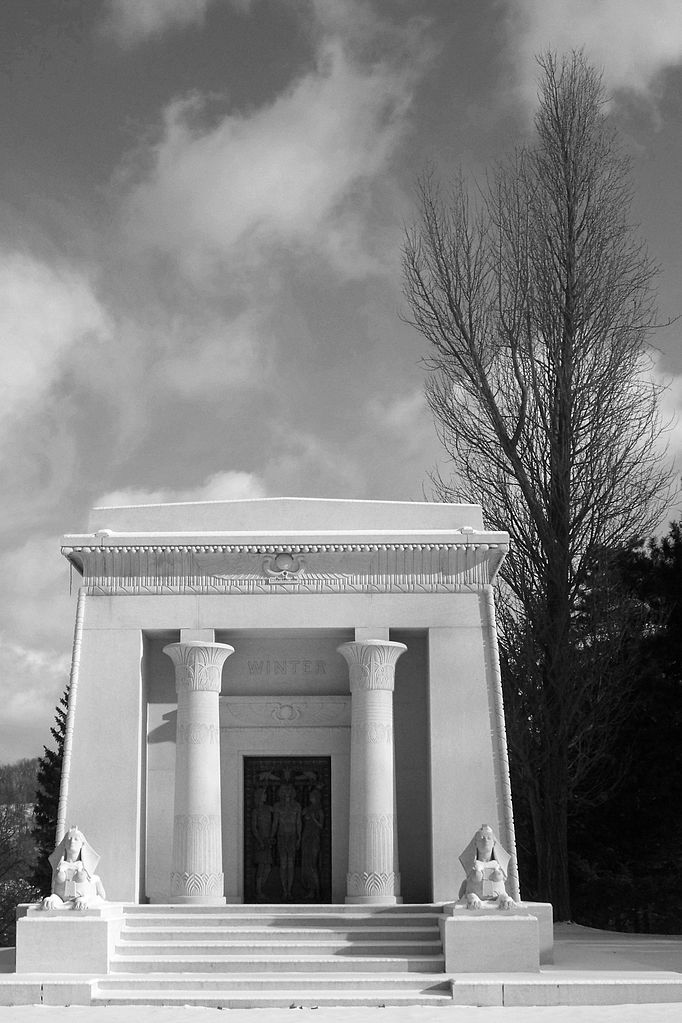This mausoleum from the early 1920s is an interesting and unusual design: a little bit Egyptian in shape, but without Egyptian details. The gorgeous stained glass inside is full of nautical references, which must refer in some way to the William S. Flower who is recorded as the first burial here in 1924. Does anyone know their significance? A Dr. William S. Flower was a dentist here in the early twentieth century, but Father Pitt cannot guess what sailing ships, hourglasses, and classical dolphins have to do with dentistry.
-
Flower Mausoleum, Allegheny Cemetery
-
Winter Mausoleum, Allegheny Cemetery
 The composite picture above is more than 75 megapixels. Expect about 22 megabytes of data if you click on it.
The composite picture above is more than 75 megapixels. Expect about 22 megabytes of data if you click on it.This is without a doubt the most spectacular Egyptian mausoleum in Pittsburgh. All the usual Egyptian elements are here, but the Winter mausoleum (1930)—whose colossal scale is hard to convey in a photograph—adds its own unique accessories. John Russell Pope, the famous beaux-arts architect, designed this mausoleum for banker Emil Winter—but “designed” is not really the right word here. The Woolworth mausoleum in Woodlawn, the Bronx, is nearly identical; Winter apparently saw it and told Pope “I want that,” and Pope gave it to him.
Mr. Winter’s amazing sphinxes bear an expression that old Pa Pitt can only describe as “snooty.”
 The bronze door depicts Mr. Winter himself, large as life and in full Pharaonic regalia, about to set off for his journey into the afterlife. Even this is identical to the bronze door of the Woolworth mausoleum, except for the substitution of Mr. Winter’s face.
The bronze door depicts Mr. Winter himself, large as life and in full Pharaonic regalia, about to set off for his journey into the afterlife. Even this is identical to the bronze door of the Woolworth mausoleum, except for the substitution of Mr. Winter’s face. Inside is a stained-glass window that reminds Father Pitt of cheap illustrated Sunday-school handouts, showing Mr. Winter properly enthroned. (It was devilishly hard to get a picture of this window, because the front doors are actually backed by a mesh screen. This was the best old Pa Pitt could do.)
Inside is a stained-glass window that reminds Father Pitt of cheap illustrated Sunday-school handouts, showing Mr. Winter properly enthroned. (It was devilishly hard to get a picture of this window, because the front doors are actually backed by a mesh screen. This was the best old Pa Pitt could do.)
-
Stevens Monument, Allegheny Cemetery
According to the cemetery’s Web site, this is probably the monument for Verlinda Stevens, who died in 1872. The marble is so badly eroded that we cannot read any of the inscriptions, but even—or perhaps especially—in this state it is quite picturesque.
-
Hartley-Given Mausoleum, Allegheny Cemetery
A typical Egyptian temple, except perhaps that it is rather grander than usual. It was built in 1913, and we can see the elements that almost invariably mark the Egyptianness of the style: the sloping sides and the lotus columns. Over the entrance we almost always find a winged sun disk or scarab entwined by serpents.
The picture above is huge if you click on it: there’s plenty of detail to appreciate, but be aware that clicking on it will cost you about twelve and a half megabytes.
-
The Fountain, Allegheny Cemetery


















